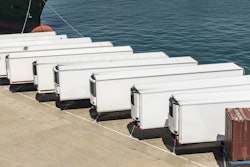Air Brake Pressure Balance Test
Bendix Commercial Vehicle Systems recommended the following procedure to determine the air pressure differences between the various axles of a single or combination vehicle. For the test, use a dual test gauge with a 0 to 150 psi range.
First, perform vehicle preparation and place the vehicle dash control valves in the normal over-the-road position.
If the vehicle being tested is a single unit, install one half of the dual test gauge directly in the number one or primary circuit delivery of the brake valve. For tractors or combination vehicles, install one half of the dual test gauge in the trailer service (control) line between the tractor and trailer. Note that this half of the test gauge will remain there for the duration of the test.
Install the other half of the test gauge in a service brake chamber at axle number one. Repeat the procedure at each axle of the vehicle combination. Note that the test gauge connection must be between the air chamber and any control valve, ideally directly in or at the chamber.
Next, gradually apply the brakes via the brake valve and record the axle pressure in the increasing column of axle number one when the brake valve primary delivery or trailer service control line pressure is at 5, 10, 15, 20, 25, 30, 40, 50 and 60 psi. Repeat the procedure for each axle of the vehicle combination and record pressure readings on the chart. (See Figure 1).
Readings during this phase of the procedure should be taken with increasing air pressure only. Do not over apply and then release, as an inaccurate reading will occur. Release the brakes fully and reapply if you have over-applied pressure.
Repeat the procedure using decreasing air pressure. Fully apply the service brakes, then gradually release and record the axle pressure in the decreasing column of the appropriate axle when the brake valve primary delivery or the trailer service line pressure is at 60, 50, 40, 30, 25, 20, 15, 10 and 5 respectively. Repeat the procedure for each axle and record the pressure readings on the chart.
Readings during this phase of the procedure should be taken with decreasing air pressure only. Do not under shoot the pressure and partially reapply pressure. An inaccurate reading will result. Fully apply the brakes and exhaust them down to the specified pressure.
When the testing is complete, uncage the parking brakes.
New Design Piloted Input Adjuster Released
As of last August, all Dana D170, D190 and D590 forward carrier assemblies have been manufactured with a piloted input shaft adjuster and input cover design. The change was made to address premature retainer bolt failures and excessive radial play between the input adjuster and cover.
The piloted design is identified by the portion of threads that have been removed from the adjuster and cover and replaced by a pilot. (See Figure 2). Additionally, the previous 8mm input adjuster retaining capscrew was replaced with a 12mm stud and jam nut.
To repair the assembly:
- Block the wheels of the vehicle and remove the driveline from the input yoke.
- Measure the input radial play. If it is greater than .010 inch, replace the assembly.
- De-stake the input nut and remove it.
- Use the correct puller to remove the input yoke assembly.
- Remove the power distribution unit cover bolts and the power divider cover assembly.
- Before you install the new piloted cover, clean any old sealant from the carrier surface.
- Apply a 1/8 inch bead of RTV to the carrier. Make sure you go around each bolt hole.
- Install the new piloted cover assembly.
- Turn the adjuster in until it is snug, then back it off one to two notches.
- Measure the end play and set it to .001 inch to .005 inch.
- Install the new retaining stud and make sure it is aligned to an adjuster slot and torques to 20 ft.-lbs.
- Install the retaining stud jam nut and torque to 65 ft.-lbs.
- Install the new input seal and reinstall the yoke assembly.
- Install the new input nut and torque to 800 to 1000 ft.-lbs.
- Stake the input nut and reinstall the driveline.
Revised Exhaust Manifold
Mack revised the exhaust manifold center section used on its ASET AC engines by reducing slip-joint clearances to improve exhaust gas sealing.
If you encounter exhaust leakage, replace the manifold center section with the revised manifold.
For ASET AC-460E and AC-460P engine models, the material composition of the exhaust manifold center section now is Ni-Resist, a material that is said to have a higher resistance to heat-induced cracking. If you have to replace an exhaust manifold center section because of cracking, use the model made from the new material. (See Figure 3).
Trailer Wiring Data
Grote released information about how to select the correct size electrical cable. Wire is used to carry current from the battery through the vehicle to various electrical components, such as lights, instruments, etc.
For automotive use, the grounded return system is used almost exclusively. In this system, a single wire is run from the battery through switches to the load and the vehicle itself provides the ground or return to the battery.
It’s important that all electric components have a good ground. In combination vehicles, it is important that a good quality and adequately sized ground wire is provided between the two vehicles to carry the current.
Wire has a certain resistance to current flow; the smaller the wire, the greater the resistance. Also, as the amount of current (amps) increases, the resistance (ohms) increases.
For a 12v system, the following two factors should be considered:
- Voltage drop is the primary consideration in selecting the proper electrical wire size. The length of wire in a circuit is the major contributing factor to voltage drop.
- The current carrying capacity of the wire should be considered. The heavy load in an undersized wire may increase the temperature of the PVC insulation above the safe level of 180 F.
NHTSA RECALL UPDATES
- Motor Coach is recalling 163 Model Year 1999 to 2003 F3500 transit buses. Where the steering arm idler bracket mounting is attached to the underside of the frame, the frame structure can crack and the idler plate can separate, leading to a loss of steering control and a crash. The company will add reinforcement gussets in order to reduce the stress where cracking might occur and will repair the existing components in the affected unit as needed.
- PACCAR is recalling 111 Model Year 2008 Kenworth T660 trucks built with Caterpillar C15 or Cummins ISX engines and equipped with Horton engine fans because durability testing revealed micro cracks in the fan blades. These cracks could develop into larger cracks, which could cause the fan to break apart while turning.
- Nissan Diesel is recalling 6074 Model Year 2005 to 2007 UD1800, UD2000, UD2300, UD2600 and UD3300 trucks equipped with Bando belt tensioners. Additionally, Hino Motors is recalling 14,588 Model Year 2005 to 2006 ND8J, NE8J, NJ8J and NV8J trucks equipped with the same Bando belt tensioners. Corrosion or rust may develop on the tensioner spindle or bushing causing the auto tensioner to become stiff or bind, which can make the drive belt detach, or the auto tensioner mounting bolts suddenly break. If the drive belt comes off, the alternator warning lamp will illuminate and if this is ignored, the condition ultimately could result in a loss of vehicle power. Dealers will replace the auto tensioner, install upgraded mounting bolts and replace the accessory drive belt.
- PACCAR is recalling 293 Model Year 2006 to 2008 Kenworth T300 trucks equipped with Cummins ISC or PACCAR PX8 engines. The jumper wire between the grid heater relay to the fuse block has been routed in such a way that the potential exists for it to rub against the radiator support. The suspect wire is down stream from the fuse. This chaff point could cause the 250 amp charge wire to arc, potentially causing a fire. Dealers will inspect the routing of the jumper wire and if it is not routed correctly, it will be inspected for rubbing or chaffing and replaced if necessary.







